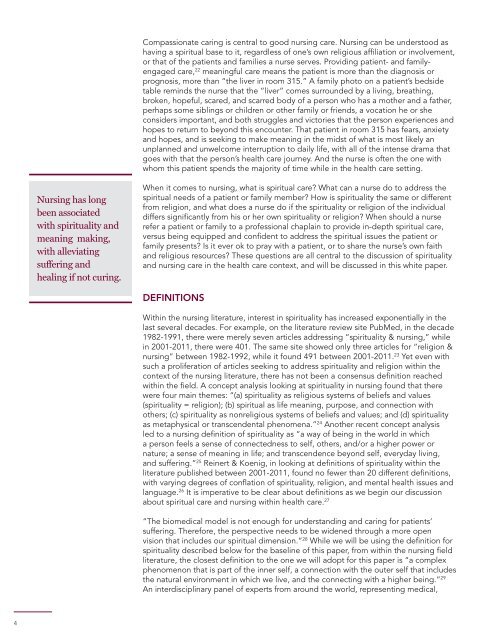S piritual Care and Nursing A Nurse’s Contribution and Practice
UsmH30a0tgV
UsmH30a0tgV
Create successful ePaper yourself
Turn your PDF publications into a flip-book with our unique Google optimized e-Paper software.
Compassionate caring is central to good nursing care. <strong>Nursing</strong> can be understood as<br />
having a s<strong>piritual</strong> base to it, regardless of one’s own religious affiliation or involvement,<br />
or that of the patients <strong>and</strong> families a nurse serves. Providing patient- <strong>and</strong> familyengaged<br />
care, 22 meaningful care means the patient is more than the diagnosis or<br />
prognosis, more than “the liver in room 315.” A family photo on a patient’s bedside<br />
table reminds the nurse that the “liver” comes surrounded by a living, breathing,<br />
broken, hopeful, scared, <strong>and</strong> scarred body of a person who has a mother <strong>and</strong> a father,<br />
perhaps some siblings or children or other family or friends, a vocation he or she<br />
considers important, <strong>and</strong> both struggles <strong>and</strong> victories that the person experiences <strong>and</strong><br />
hopes to return to beyond this encounter. That patient in room 315 has fears, anxiety<br />
<strong>and</strong> hopes, <strong>and</strong> is seeking to make meaning in the midst of what is most likely an<br />
unplanned <strong>and</strong> unwelcome interruption to daily life, with all of the intense drama that<br />
goes with that the person’s health care journey. And the nurse is often the one with<br />
whom this patient spends the majority of time while in the health care setting.<br />
<strong>Nursing</strong> has long<br />
been associated<br />
with s<strong>piritual</strong>ity <strong>and</strong><br />
meaning making,<br />
with alleviating<br />
suffering <strong>and</strong><br />
healing if not curing.<br />
When it comes to nursing, what is s<strong>piritual</strong> care? What can a nurse do to address the<br />
s<strong>piritual</strong> needs of a patient or family member? How is s<strong>piritual</strong>ity the same or different<br />
from religion, <strong>and</strong> what does a nurse do if the s<strong>piritual</strong>ity or religion of the individual<br />
differs significantly from his or her own s<strong>piritual</strong>ity or religion? When should a nurse<br />
refer a patient or family to a professional chaplain to provide in-depth s<strong>piritual</strong> care,<br />
versus being equipped <strong>and</strong> confident to address the s<strong>piritual</strong> issues the patient or<br />
family presents? Is it ever ok to pray with a patient, or to share the nurse’s own faith<br />
<strong>and</strong> religious resources? These questions are all central to the discussion of s<strong>piritual</strong>ity<br />
<strong>and</strong> nursing care in the health care context, <strong>and</strong> will be discussed in this white paper.<br />
DEFINITIONS<br />
Within the nursing literature, interest in s<strong>piritual</strong>ity has increased exponentially in the<br />
last several decades. For example, on the literature review site PubMed, in the decade<br />
1982-1991, there were merely seven articles addressing “s<strong>piritual</strong>ity & nursing,” while<br />
in 2001-2011, there were 401. The same site showed only three articles for “religion &<br />
nursing” between 1982-1992, while it found 491 between 2001-2011. 23 Yet even with<br />
such a proliferation of articles seeking to address s<strong>piritual</strong>ity <strong>and</strong> religion within the<br />
context of the nursing literature, there has not been a consensus definition reached<br />
within the field. A concept analysis looking at s<strong>piritual</strong>ity in nursing found that there<br />
were four main themes: “(a) s<strong>piritual</strong>ity as religious systems of beliefs <strong>and</strong> values<br />
(s<strong>piritual</strong>ity = religion); (b) s<strong>piritual</strong> as life meaning, purpose, <strong>and</strong> connection with<br />
others; (c) s<strong>piritual</strong>ity as nonreligious systems of beliefs <strong>and</strong> values; <strong>and</strong> (d) s<strong>piritual</strong>ity<br />
as metaphysical or transcendental phenomena.” 24 Another recent concept analysis<br />
led to a nursing definition of s<strong>piritual</strong>ity as “a way of being in the world in which<br />
a person feels a sense of connectedness to self, others, <strong>and</strong>/or a higher power or<br />
nature; a sense of meaning in life; <strong>and</strong> transcendence beyond self, everyday living,<br />
<strong>and</strong> suffering.” 25 Reinert & Koenig, in looking at definitions of s<strong>piritual</strong>ity within the<br />
literature published between 2001-2011, found no fewer than 20 different definitions,<br />
with varying degrees of conflation of s<strong>piritual</strong>ity, religion, <strong>and</strong> mental health issues <strong>and</strong><br />
language. 26 It is imperative to be clear about definitions as we begin our discussion<br />
about s<strong>piritual</strong> care <strong>and</strong> nursing within health care. 27<br />
“The biomedical model is not enough for underst<strong>and</strong>ing <strong>and</strong> caring for patients’<br />
suffering. Therefore, the perspective needs to be widened through a more open<br />
vision that includes our s<strong>piritual</strong> dimension.” 28 While we will be using the definition for<br />
s<strong>piritual</strong>ity described below for the baseline of this paper, from within the nursing field<br />
literature, the closest definition to the one we will adopt for this paper is “a complex<br />
phenomenon that is part of the inner self, a connection with the outer self that includes<br />
the natural environment in which we live, <strong>and</strong> the connecting with a higher being.” 29<br />
An interdisciplinary panel of experts from around the world, representing medical,<br />
4


